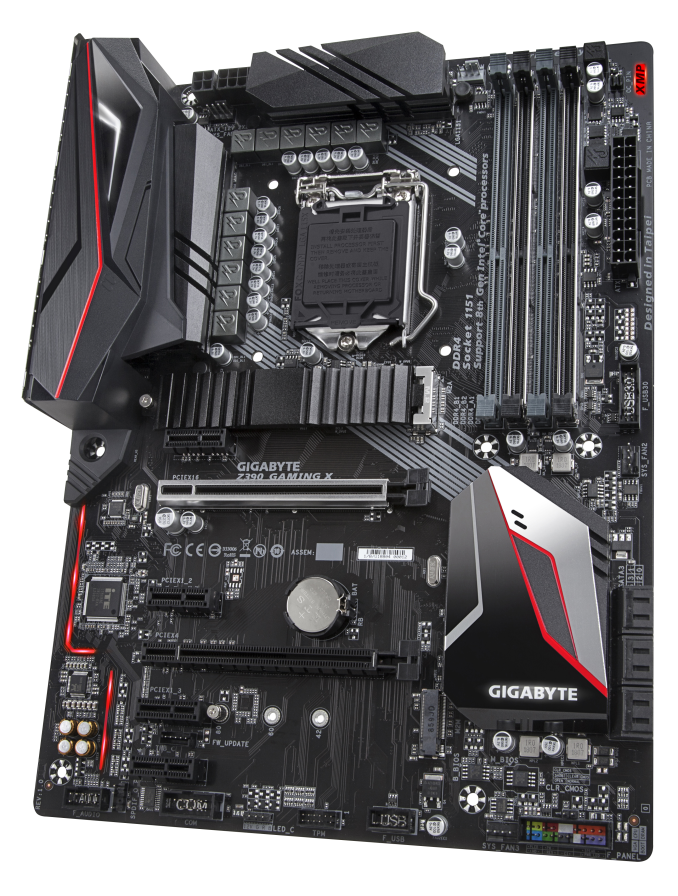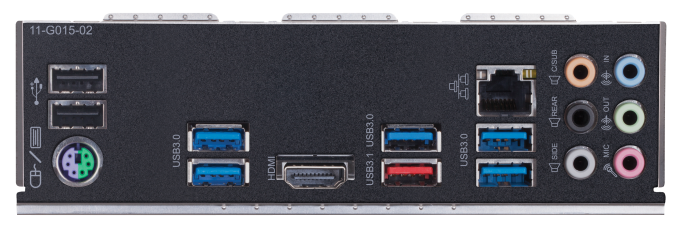Intel Z390 Motherboard Overview: 50+ Motherboards Analyzed
by Ian Cutress & Gavin Bonshor on October 8, 2018 10:53 AM EST- Posted in
- Motherboards
- Intel
- MSI
- Gigabyte
- ASRock
- EVGA
- Asus
- NZXT
- Supermicro
- Z390
GIGABYTE Z390 Gaming X
The GIGABYTE Z390 Gaming X looks to share a very similar PCB and design as the Z390 Gaming SLI with a black and silver design (red accents) but looks to enter the market at a lower price point. Both boards feature much of the same characteristics including power delivery, dual 8 and 4-pin CPU power inputs and PCIe slot layout, but replaces Realtek ALC1220-VB codec and instead opts for a cheaper Realtek ALC892. The Gaming X drops SLI support and features two full-length PCIe 3.0 slots which run at x16 and x4 respectively. The top slot also has a coating of metal PCIe slot protection and two-way CrossFire is officially supported; there are also three PCIe 3.0 x1 slots included on the board.
On the storage front, the Z390 Gaming X has a pair of PCIe 3.0 x4/SATA M.2 slots with the top slot being treated to an M.2 heatsink. The board also has a total of six SATA ports which allow for RAID 0, 1, 5 and 10 arrays to be used. The board also offers a maximum capacity of up to 64 GB of system memory, with the rated XMP specification currently unknown as of yet.
USB wise the board has a total of eight ports which consist of one USB 3.1 Gen2 Type-A, five USB 3.0 Type-A and two USB 2.0 ports; an additional two USB 3.0 and two USB 2.0 ports can be made available through the internal headers on the board. The rest of the rear panel consists of a single HDMI out, a PS/2 combo port, a single LAN port powered by an Intel I219V Gigabit controller and six 3.5 mm audio jacks which are controlled by a Realtek ALC892 HD audio codec.
The GIGABYTE Z390 Gaming X's pricing stands at $150 as it sits towards the bottom of GIGABYTEs Z390 product range. The board is aimed towards gamers with lower budgets and looks to make GIGABYTE competitive in the entry-level Z390 market.












79 Comments
View All Comments
Smell This - Tuesday, October 9, 2018 - link
Much.Of.
The.
Same.
2 HSIO lanes per Gen 2 port and WiFi. Wow (rolling I-eyeballs) ...
MadAd - Tuesday, October 9, 2018 - link
58 motherboards, only 13 of which are smaller than ATX. When on earth are we going to move off this outdated oversized format? Its just more of the same every time, so depressing.gavbon - Wednesday, October 10, 2018 - link
13 is better than 0, or 12 :DMadAd - Wednesday, October 10, 2018 - link
Considering very small form formats (ITX) are harder to build for and only 7 are uATX, a size which is the most useful to transition away from ATX then no, it feels like an afterthought from a lazy industry. I mean who uses more than 1 main video card and 2-4 sticks of ram in a gaming PC these days? Even water builds into uATX isnt that hard to accomplish.After literally decades ATX should be a choice for edge cases not a mainstream build.
shaolin95 - Monday, October 22, 2018 - link
who cares about midge boards!Edkiefer - Wednesday, October 10, 2018 - link
All these MB with 2x 8 pin power inputs, is both mandatory and if so I guess new PSU will need 2x 8pin now.entity279 - Wednesday, October 10, 2018 - link
so it's ok to just buy SM motherboards now with them being involved in a security scandal?gavbon - Thursday, October 11, 2018 - link
I currently have the Supermicro C9Z390-PGW awaiting to go on the test bench next week, so from a consumers standpoint, I could potentially shed light on that board. As far as the Chinese/Supermicro/Spy scandal goes, I don't want to speculate without the finer details.eastcoast_pete - Wednesday, October 10, 2018 - link
Ian & Gavin, thanks for the overview.@ both - Question: I've read that Intel, to deal with its bad planning/capacity problems on 14 nm, has contracted the fabbing of some of its chipsets out to TSMC, specifically in TSMC's 22 nm tech. Is that correct, and did you have a chance to confirm that the new 390s used by these boards are indeed made by Intel on their 14 nm FinFET tech, or are they made by a contractor (TSMC)?
DanNeely - Wednesday, October 10, 2018 - link
AFAIK the chipsets being reverted to 22nm are using Intel's 22nm process in old unupgraded fabs. Doing so would be far less work than porting to a process from a different company; the latter would require massive rework to follow a completely different set of design rules.